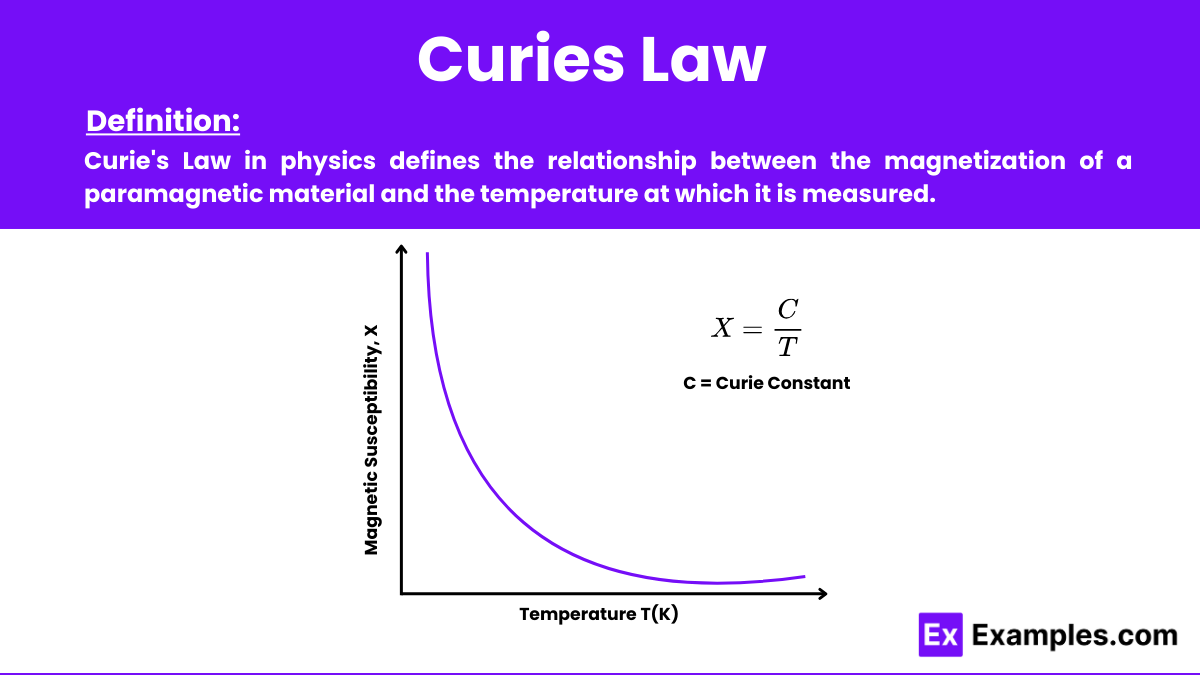What does Curie's Law state about the magnetization of a material?
It is directly proportional to temperature
It is inversely proportional to temperature
It is independent of temperature
It is proportional to the square of the temperature


Curie’s Law in physics defines the relationship between the magnetization of a paramagnetic material and the temperature at which it is measured. This law, named after the renowned physicist Pierre Curie, states that the magnetization of a paramagnetic material is directly proportional to an applied magnetic field and inversely proportional to its temperature. In simpler terms, as the temperature increases, the ability of a paramagnetic material to magnetize decreases, provided that the magnetic field strength remains constant.
Paramagnetic refers to the property of certain materials that are weakly attracted by an external magnetic field. This behavior occurs because of the presence of unpaired electrons in the atomic or molecular structure of the material. When exposed to a magnetic field, these unpaired electrons align their spins in the direction of the field, creating a weak attraction.
The Curie temperature (or Curie point) is the specific temperature at which a ferromagnetic material transitions to a paramagnetic state. When you heat a ferromagnetic material above its Curie temperature, its inherent magnetic properties diminish, and it no longer maintains a permanent magnetization. This phenomenon occurs because the thermal energy disrupts the alignment of the magnetic dipoles within the material, causing them to lose their ordered arrangement and become randomly oriented.
Curie’s Law helps describe the magnetic susceptibility of paramagnetic materials. It states that the magnetic susceptibility (𝜒χ) of a paramagnetic material is inversely proportional to its absolute temperature (T). The law is mathematically expressed as:
Each atom or ion in a paramagnetic material possesses a magnetic moment (𝜇μ). In an external magnetic field, the magnetic moment tends to align with the field. The potential energy of a magnetic moment in a magnetic field is:
The probability of finding a magnetic moment at a given energy level follows the Boltzmann distribution:
where:
In this case, 𝐸=𝑈=−𝜇𝐵.
The net magnetization 𝑀 is the sum of all magnetic moments, which depends on the balance between the magnetic alignment due to the external field and the thermal agitation that causes randomization.
The average magnetic moment per atom due to thermal agitation is proportional to 𝜇𝐵/𝑘𝑇 for weak magnetic fields, leading to:
The magnetization 𝑀M is the total magnetic moment per unit volume:
The magnetic sensitivity 𝜒 is defined as:
𝜒=𝑀/𝐵=𝑛𝜇₀𝜇/𝑘𝑇
Curie’s Law relates the sensitivity to the absolute temperature:
This equation shows that magnetic sensitivity is inversely proportional to the temperature, which is the essence of Curie’s Law.

This Curie’s Law involves the inverse proportionality of magnetic sensitive to temperature minus the Curie-Weiss constant, commonly used in paramagnetic behavior.
It states that the symmetry elements present in the causes of a physical phenomenon are also found in the phenomenon itself.
Pierre Curie, introduced Curie’s Law, fundamentally advanced magnetic material research.
Text prompt
Add Tone
10 Examples of Public speaking
20 Examples of Gas lighting
What does Curie's Law state about the magnetization of a material?
It is directly proportional to temperature
It is inversely proportional to temperature
It is independent of temperature
It is proportional to the square of the temperature
If the temperature of a paramagnetic material is doubled, what happens to its magnetization according to Curie's Law?
It doubles
It halves
It remains the same
It quadruples
What is the effect of increasing temperature on the magnetization of a paramagnetic material?
Increases
Decreases
Remains constant
Fluctuates
How is the Curie constant (C) determined for a material?
It is a universal constant
It depends on the material's specific properties
It depends on the external magnetic field
It is determined by the temperature
What is the relationship between susceptibility (χ) and temperature (T) in Curie's Law?
χ is directly proportional to T
χ is inversely proportional to T
χ is proportional to T²
χ is independent of T
According to Curie's Law, what happens to the magnetization of a paramagnetic material at absolute zero temperature?
It becomes zero
It becomes infini
It is maximum
It remains unchanged
What is the SI unit of the Curie constant (C)?
A/m
K/A
J/T
K
In Curie's Law, if the Curie constant of a material is known, what else is needed to find its magnetization at a given temperature?
Magnetic field strength
Temperature
Both A and B
None of the above
What type of materials does Curie's Law primarily apply to?
Ferromagnetic materials
Diamagnetic materials
Paramagnetic materials
All magnetic materials
How does Curie's Law relate to the magnetic susceptibility (χ) of a paramagnetic material?
χ = C/T
χ = T/C
χ = C*T
χ = T - C
Before you leave, take our quick quiz to enhance your learning!

